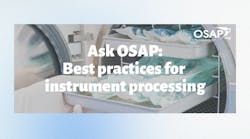Ask OSAP: What's the best workflow for instrument processing?
“Ask OSAP” is a recurring question and answer provided by the Office of Organization for Safety, Asepsis and Prevention, dentistry’s advocate for the safe and infection-free delivery of oral health care. This entry takes on the question of best practices for instrument processing.
Question: We are preparing to build a new dental operatory suite, and I’d like information on the most current workflow for instrument processing, i.e., dirty to clean, or is there a recommended design or workflow? Our design is U-shaped with a sink in the middle. We will have an ultrasonic machine and two autoclaves.
I was always taught that all things stored on the dirty side of sterilization in all cabinetry above and below needs to be dirty and nothing clean. Is this correct?
From OSAP: Requirements vary by state, and you may want to also contact your state dental board or state department of health–dental program for further information. But in terms of general information on this topic, the 2003 CDC guidelines for infection control in dentistry states the following regarding the instrument processing area:
Instrument processing area
Dental health-care professionals should process all instruments in a designated central processing area to more easily control quality and ensure safety (248).* The central processing area should be divided into sections for:
- receiving, cleaning, and decontamination
- preparation and packaging
- sterilization
- storage
Ideally, walls or partitions should separate the sections to control traffic flow and contain contaminants generated during processing. When physical separation of these sections cannot be achieved, adequate spatial separation might be satisfactory if the DHCPs who process instruments are trained in work practices to prevent contamination of clean areas (248). Space should be adequate for the volume of work anticipated and the items to be stored (248).
You might also be interested in: Ask OSAP: Does jewelry cause cross-contamination?
Receiving, cleaning, and decontamination
Reusable instruments, supplies, and equipment should be received, sorted, cleaned, and decontaminated in one section of the processing area. Cleaning should precede all disinfection and sterilization processes; it should involve removal of debris as well as organic and inorganic contamination. Removal of debris and contamination is achieved either by scrubbing with a surfactant, detergent, and water, or by an automated process (e.g., ultrasonic cleaner or washer-disinfector) using chemical agents.
If visible debris, whether inorganic or organic matter, is not removed, it will interfere with microbial inactivation and can compromise the disinfection or sterilization process (244, 249–252). After cleaning, instruments should be rinsed with water to remove chemical or detergent residue. Splashing should be minimized during cleaning and rinsing (13). Before final disinfection or sterilization, instruments should be handled as though contaminated.
Considerations in selecting cleaning methods and equipment include efficacy of the method, process, and equipment; compatibility with items to be cleaned; and occupational health and exposure risks. Use of automated cleaning equipment (e.g., ultrasonic cleaner or washer-disinfector) does not require presoaking or scrubbing of instruments and can increase productivity, improve cleaning effectiveness, and decrease worker exposure to blood and body fluids. As such, using automated equipment can be safer and more efficient than manually cleaning contaminated instruments (253).
If manual cleaning is not performed immediately, placing instruments in a puncture-resistant container and soaking them with detergent, a disinfectant/detergent, or an enzymatic cleaner will prevent drying of patient material and make cleaning easier and less time-consuming. Use of a liquid chemical sterilant/high-level disinfectant (e.g., glutaraldehyde) as a holding solution is not recommended (244). Using work-practice controls (e.g., long-handled brush) to keep the scrubbing hand away from sharp instruments is recommended (14).
To avoid injury from sharp instruments, DHCPs should wear puncture-resistant, heavy-duty utility gloves when handling or manually cleaning contaminated instruments and devices (6). Employees should not reach into trays or containers holding sharp instruments that cannot be seen (e.g., sinks filled with soapy water in which sharp instruments have been placed). Work-practice controls should include use of a strainer-type basket to hold instruments and forceps to remove the items. Because splashing is likely to occur, a mask, protective eyewear or face shield, and gown or jacket should be worn (13).1
Infection Control and Management of Hazardous Materials for the Dental Team (7th edition) is also an excellent resource.
*parenthetical numbers refer to references within the CDC report
Interested in learning more? OSAP member benefits are designed to save you money and time, connect you with colleagues around the world, enhance your dental infection prevention, occupational health, and patient safety knowledge and skills, and help you meet your professional goals. Here's how to join.
Reference
1. Kohn WG, Collins AS, Cleveland JL, Harte JA, Eklund KJ, Malvitz DM, Centers for Disease Control and Prevention (CDC). Guidelines for infection control in dental health-care settings—2003. Accessed June 16, 2022. http://www.cdc.gov/mmwr/preview/mmwrhtml/rr5217a1.htm






